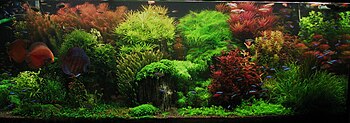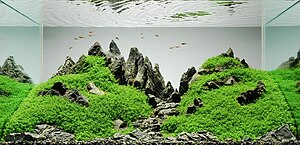사용자:Juyeoung/Aquascaping (1)

Aquascaping 은 수생 식물,뿐만 아니라,바위,돌,동굴작업 ,또는 유목을 수족관 내에 미적으로 배치하는 작업입니다. — 사실상, 물속에서 정원을 가꾸는 겁니다. Aquascape 꾸미는 방식에는 전혀다른 여러가지 스타일들이 있습니다, 네덜란드 정원 스타일이나 자연에서 영감을 받은 일본 스타일이 있습니다. 일반적으로 aquascape 어항에는 식물 뿐만 아니라 물고기도 있지만, 식물만 aquascape 할 수 도 있고 또는 암석이나 다른 구성물 로 구성할 수 있고, 심지어 식물이 없을 수도 있습니다.
비록 aquascaping의 주요 목적은 아름다운 물속 풍경을 만들어 내는것 이지만 , 어항을 유지 관리하고 수초들을 성장시킬 수 있는 요구조건을 고려하여 갖춰놓는 기술적인 부분도 있습니다.[1] 많은 요소들이 반듯이 균형을 이루져야만, 어항 이라는 닫힌 생태계 안에서 aquascape를 성공시킬 수 있습니다. 이러한 요소들에는 여과, 물속에서 광합성을 위한 충분 한 수준의 이산화탄소, 조명 ,그리고 조류를 관리 해야합니다.[2]
취미 Aquascape 활동가들은 식물을 교환하고 , 콘테스트를 열고, 사진을 공유하고 , 정보를 공유 합니다.[3][4][5] 미국에 위치한 Aquatic Gardeners 협회는 1,200 회원을 보유하고 있습니다.
Designs[편집]
네덜란드 스타일[편집]

네덜란드 스타일의 수족관은 다양한 잎 색깔, 크기, 질감을 가진 다양한 종류의 식물들이 꽃 정원에 풍성하게 전시되어 있어야 하기 때문에 꽃 정원 속의 육생 식물을 보는것과 같다 . 이러한 스타일은 Netherlands (네덜란드) 에서 1930년도 부터 시작 및 발전되었다. 담수의 수족관 장비가 상업적으로 사용가능해 지면서. 서로다른 높이의 계단식에 위치된 식물들을 강조하거나 종종 돌과 유목들을 제외 하기도 한다. 가로로 늘어선 식물들을 일컬어 "네덜란드 거리"라고 한다.[6] 비록 많은 종류의 식물들이 사용되지만, 좋은 품질의 식물을 한군데 모아 반듯하게 다듬는것을 전형적으로 볼 수 있다, 예를 들면 Limnophila aquatica 그리고 다양한 타입의 Hygrophila, 붉은 잎을 가지고 있는Alternanthera reineckii, Ammania gracilis, 그리고 선별된 Rotala 는 어러 색으로 강조된다. 수조 내부에 80%가 넘는 부분이 수초로 덮여 있어, 아주 조금 또는 거의 바닥이 보이지 않는다. 높게 자라난 수초들은 뒤에 있는 유리를 가리게 되고 , 그 목적은 뒤쪽에 커다란 장비들을 가리는데 있다.[7]
Japanese styles[편집]
자연적인 스타일[편집]

A contrasting approach is the "nature aquarium" or Japanese style, introduced in the 1990s by Takashi Amano. Amano's three-volume series, Nature Aquarium World, sparked a wave of interest in aquarium gardening, and he has been cited as having "set a new standard in aquarium management".[8] Amano's compositions drew on Japanese gardening techniques that attempt to mimic natural landscapes by the asymmetrical arrangement of masses of relatively few species of plants, and which set rules governing carefully selected stones or driftwood, usually with a single focal point. The objective is to evoke a terrestrial landscape in miniature, rather than a colorful garden. This style draws particularly from the Japanese aesthetic concepts of Wabi-sabi (侘寂) (侘寂), which focuses on transience and minimalism as sources of beauty. Plants with small leaves like Glossostigma elatinoides, Eleocharis acicularis, Eleocharis parvula, Echinodorus tenellus, Hemianthus callitrichoides, Riccia fluitans, small aquatic ferns, Staurogyne repens, and Java moss (Versicularia dubyana or Taxiphyllum barbieri) are often used to emulate grass or moss. Colors are more limited than in the Dutch style, and the hardscape is not completely covered. Fish, or freshwater shrimp such as Caridina multidentata and Neocaridina heteropoda, are usually selected to complement the plants and control algae, but for reasons of minimalism the number of species are often limited.[9]
References[편집]
- ↑ “Aquascaping 101 – An Introductory Guide for Beginners”. 《FishTankSetups》 (미국 영어). 2017년 6월 16일. 2017년 6월 21일에 확인함.
- ↑ 인용 틀이 비었음 (도움말)
- ↑ Mitchell, Sherry (2003년 10월 2일). “The Fish Are Fine, but the Plants Are Fabulous”. 《Washington Post》. 2010년 7월 27일에 확인함.
- ↑ Wei, Tan Karr (2007년 7월 26일). “The exotic trade of aquascaping”. 《Malaysia Star》. 2010년 7월 27일에 확인함.
- ↑ Netburn, Deborah (2009년 9월 19일). “Aquascaping: Aquarium meets terrarium in the Japanese-inspired design practice”. 《Los Angeles Times》. 2010년 7월 27일에 확인함.
- ↑ Hudson, Robert Paul (30 May 2008), Going Dutch 웹아카이브 틀에 오류가 있습니다:
|url=값을 확인하십시오. 비어 있음. . - ↑ Hennig, Matt (June 2003), Amano versus Dutch: Two art forms in profile, Tropical Fish Hobbyist, pp. 68–74.
- ↑ Axelrod, Herbert R., Warren E. Burgess, Neal Pronek, Glen S. Axelrod and David E. Boruchowitz (1998), Aquarium Fishes of the World, Neptune City, N.J.: T.F.H. Publications, p. 718, ISBN 0-7938-0493-0.
- ↑ The Nature Aquarium Style, 8 January 2014.
[[분류:수족관]] [[분류:공예]] [[분류:취미]] [[분류:애완동물 용품]] [[분류:정원 종류]]
